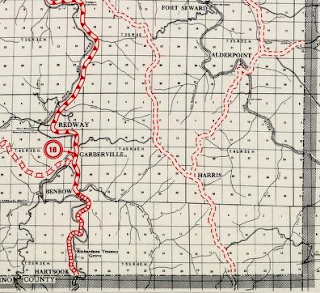The history of what would become US Route 101 ("US 101") at Confusion Hill begins with the approval of the
1909 First State Highway Bond Act.
The First State Highway Bond Act was approved by voters during 1910 and
was the genesis point of some of the most notable highways in
California. Legislative Route Number 1 ("LRN 1") as originally plotted was a
new State Highway which was designated between San Francisco north to
Crescent City. The route of LRN 1 would be extended to the Oregon State
Line during the 1919 Third State Highway Bond Act and was came be known as the
Redwood Highway. The planned LRN 1 can be seen aligned between
Garberville of Humboldt County and Cummings of Mendocino County on the 1917 California State Automobile Association Map.
Prior to the construction of LRN 1 wagon borne traffic heading north from Cummings to Humboldt County had to ascend the treacherous Rattlesnake Grade (also known as the Bell Springs Grade). The Rattlesnake Grade is described in the October 1912 California Highway Bulletin as being only passable during the summer months. The initial northward climb on the Rattlesnake Grade ascended slopes as high as 20% the from Cummings to the 4,100 foot high Bell Springs Mountain. The descent from Bell Mountain to Dyerville (on CA 254/Avenue of the Giants) is described as having grades as steep as 30% amid an elevation drop of just over 3,900 feet. The construction of LRN 1 (then known as the Mendocino State Highway) sought to follow the South Fork Eel River watershed to bypass the Rattlesnake Grade. Note; the Rattlesnake Grade can be seen above on the 1917 California State Automobile Association Map between Cummings and Dyerville.
Much of the Rattlesnake Grade still exists as modern Bell Springs Road. The Rattlesnake Grade can be seen in detail between Garberville-Cummings on the 1935 Division of Highways Maps of Humboldt County and Mendocino County.
The completed Redwood Highway/LRN 1 between Cummings and Garberville can be seen on the 1920 Clason Highway Map of California. The replacement of the Rattlesnake Grade with the new alignment of the Redwood Highway/LRN 1 was of such a scale that it rivaled the likes of other First State Highway Bond Act roads the Old Ridge Route (LRN 4).
In November 1926 the US Route System was created. US Route 101 from San Francisco north to Crescent City was aligned over the Redwood Highway. Both US 101 and the Redwood Highway between Garberville and Cummings can be seen on the 1927 Rand McNally Highway Map of California.
A new segment of the Redwood Highway between Piercy and Rock Creek can be seen in the October 1926 California Highways & Public Works just prior to it becoming US 101.
The future site of Confusion Hill can be seen south of the confluence of the South Fork Eel River and Red Mountain Creek on the 1935 Division of Highways Map of Mendocino County.
As noted in the intro Confusion Hill was opened in 1949 as an attraction oriented towards optical illusion displays. Confusion Hill was the creation of George Hudson who took inspiration from the Oregon Vortex and Santa Cruz Mystery Spot after returning from World War II. More regarding the history of Confusion Hill can be found on the Confusion Hill website.
The Gravity House of Confusion Hill can be seen in this undated vintage post card.
The March-April 1965 California Highways & Public Works cites that slides occurred on US 101 at; Leggett, Piercy, Richardson Grove, and Cummings during the 1964 Christmas Floods.
The Garberville-Cummings segment of US 101 initially remained mostly unchanged after the 1964 Christmas Floods which is evident on the 1967 Division of Highways State Map.
US 101 is shown as an expressway south of Garberville to the vicinity of Richardson Grove State Park on the 1969 Division of Highways State Map. US 101 is shown to have a planned bypass route of Richardson Grove State Park which shown continuing to an existing expressway segment near Cummings.
The 1970 Division of Highways State Map shows the Richardson Grove bypass under construction, ultimately it never would be completed.
The slide zone north of Confusion Hill along with the original grade of US 101 up close.
The entrance to Confusion Hill now is located in the gift shop building.


















































Comments